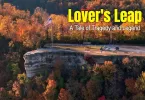Admitted to the union in 1889 as the fortieth state (on the same day neighboring North Dakota was also admitted as a state), South Dakota has been inhabited by humans for hundreds of years, maybe more.
The first known European contact with Native Americans in South Dakota was in 1743, by a group of French explorers. They claimed the land for France, but it became a Spanish territory only two decades later. Eventually, it became part of the United States in the 1803 Louisiana Purchase. The Arikara Native American tribe, which had been the dominant tribe in the area since about 1500 A.D. was replaced by the Sioux tribe around the time of the Louisiana Purchase.
South Dakota is best known today for being the home of the infamously (and formerly) lawless town of Deadwood, for being the location of Mount Rushmore, and for being the setting of the later books in the Little House on the Prairie series by Laura Ingalls Wilder. As you can imagine, South Dakota has accumulated a host of intriguing folklore tales all its own. Here are some of the highlights of it.
Creepy Sica Hollow
The Sioux tribe of South Dakota believed Sica Hollow to be haunted and refused to hunt thereafter making this discovery some centuries ago. The ravine, heavily forested, was named Sica Hollow by the Sioux because “Sica” means “evil” in their language.
There are several things about Sica Hollow the Sioux found to be evil, including the fact that the water there runs red. It is due to high mineral content, but there was no way of knowing this centuries ago. There is also a path in the forest of the ravine called The Trail of Spirits; this path has red bogs in it that bubble up, and the Sioux believed it to be the earthly flesh and blood of their departed ancestors. Tree stumps in the ravine are also said to glow in the dark… at least some of them do.
To add to the ravine’s reputation for evil, there have been sightings of a Bigfoot-like creature there, as well as sightings of Native American spirits. Some visitors report hearing disembodied war cries, voices, and chanting. Plus, there were a few mysterious disappearances of people there in the 1970’s. Were the Sioux right about Sica Hollow? There are certainly people today who believe they were.
The Famous Bullock Hotel
Anyone who has ever watched HBO’s TV series Deadwood knows about Sheriff Seth Bullock; he is the main character of the show and the moral compass for the lawless encampment that eventually turns into a town. Of course, Seth Bullock is more than just a character on TV. He was also a real person, and an important historical figure in the early history of Deadwood, South Dakota. Bullock was the town’s first sheriff and became a well-to-do resident (and personal friend of President Theodore Roosevelt) during the decades he lived there. He even built the town’s first fancy hotel, fittingly called the Bullock Hotel. It was constructed between 1894 and 1896.
Bullock enjoyed his hotel, so much so that his ghost is said to still reside there to this day. Reports of hauntings at the Bullock hotel are so common that it has been featured on several ghost-hunting TV shows. Workers and visitors alike have said they have heard Bullock’s boots thumping on the stairs, and have smelled his favorite cigars wafting through the place. The restaurant in the cellar of the hotel has had glassware broken more than once by being tossed by an invisible force, and the sound of an absent piano playing ragtime music is sometimes heard there.
The Haunted Easton Castle
Located in Aberdeen, South Dakota, the Easton Castle is a large house built from yellow bricks. Built in the Queen Anne style and with thirty rooms, it was constructed around 1890 and owned by Carroll Francis Easton. Easton’s housekeeper, Leslie Gage, just happened to be the niece of L. Frank Baum, the author of the Wizard of Oz books. Leslie was said to be the inspiration for the character of Dorothy, and the yellow bricks that built the house cannot be mistaken in the famous Yellow Brick Road of the stories.
Leslie’s ghost is said to haunt the house on the third floor, though she has been seen in most other parts of the house, as well. Easton’s son is also said to haunt the house; the fact that he went a little crazy after he lost his parents and did not keep up the property, leaving it looking a bit creepy, is probably what initially made locals think the place was haunted.
In addition to sightings of Leslie Gage’s ghost and the ghost of Easton’s son, there are also reports of disembodied footsteps in the house, stairs that creak when no one is on them, disembodied voices, and an unknown spirit that wielded a knife and once chased a guest out of the house.
The Superpowered Horse of Jesse James
Did you know the famous outlaw Jesse James had a horse with superpowers? Most historians would tell you that is impossible, but locals in the town of Garretson, South Dakota to this day will tell you it’s true. The local legend says that Jesse James once evaded capture by the US Marshalls by leaping his horse over nearby Devil’s Gulch. Now, Devil’s Gulch is quite wide, as well as deep, being sixty feet deep and twenty feet wide. Most horses would shy away from trying to jump across something so imposing, but Garretson locals swear Jesse James’s horse did it, allowing the outlaw to ply his chosen trade for a while longer than he otherwise might have.





